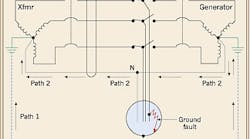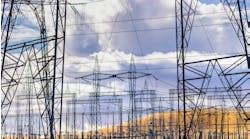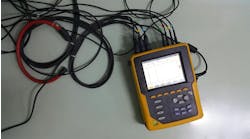Ground-Fault Current: Problems and Solutions
When designing ground-fault protection (GFP) for a power distribution system, you should always consider the nature of the power source. If the power source is from a separately derived system, you must follow certain rules and guidelines in order for the GFP to work properly and protect the system.
Per the National Electrical Code (NEC), we know that an engine generator set (gen-set) is a separately derived system. The effect of a gen-set and its transfer switch on the operation of GFP equipment requires close attention, mainly because of the multiple neutral-to-ground connections.
Let's take a detailed look at what's involved and see how to avoid the pitfalls of improper designs and installations. The following is excerpted from EC&M Books' “Practical Guide to Ground Fault Protection” and updated to the requirements of the 2005 NEC.
NEC issues. Section 250.20(B) establishes when the power system shall be grounded, while 250.20(D) requires the grounding of separately derived systems. However, according to FPN No. 1, when the neutral conductor of an alternate power source is solidly connected to the service supplied system, that alternate power source is not considered a separately derived system. What does this mean?
If a separately derived source meeting the requirements of 250.20(B) includes an alternate power source whose neutral conductor is solidly connected to that of the preferred source, the alternate source neutral is considered grounded through the ground at the preferred source service disconnect. In other words, sometimes the neutral of a gen-set power source will be grounded at the gen-set neutral; other times, it won't. (To see what you must consider before deciding when to ground the neutral, see “When You Should Ground and Switch the Gen-Set Neutral” sidebar on page 31 and “When You Should Not Ground the Gen-Set Neutral” sidebar on page 32.)
Problems from multiple neutral-to-ground connections. Two major problems arise from these connections.
Incomplete ground-fault sensing. Consider a 3-pole transfer switch with zero-sequence GFP at the service, as shown in Fig. 1. Suppose a fault occurs between one of the phase conductors and the metallic conduit enclosing these conductors. The resulting ground-fault current has two paths it can follow in returning to the transformer neutral.
Path 1 is directly back to the transformer along the equipment grounding conductor. Path 2 is along the equipment grounding conductor to the point where the gen-set is grounded, then to the gen-set neutral, and finally along the neutral conductor back to the transformer neutral.
Keep in mind that a zero-sequence GFP acts when it senses a predetermined value of current imbalance. So, the current following Path 2 will pass through the transformer GFP sensor just as though it were normal load current, and the zero-sequence GFP will sense only the fault current following Path 1. As a result, you would have incomplete sensing of the total fault current.
Nuisance tripping. Now, consider a 3-pole transfer switch and zero-sequence GFP with an unbalanced load, as shown in Fig. 2. Again, the unbalanced current in the neutral has two paths to follow. Path 1 is directly to the service neutral. Path 2 is to the gen-set neutral, through the gen-set grounding electrode and — by way of metallic equipment enclosures, conduit, fittings, etc. — back to the service neutral.
The current through Path 2 would have the same effect on the ground-fault sensor as ground-fault current. Therefore, an unbalanced load would affect the sensitivity of the GFP sensor and could cause it to trip the breaker even though a fault or short-circuit current does not exist.
The problem with both GFP connections discussed above is that the neutrals of the transformer and gen-set are tied together in the transfer switch. There are three possible solutions to overcome the above-mentioned problems.
Solution 1: 4-pole transfer switch. This type of transfer switch provides complete isolation of service and gen-set neutral conductors, thereby eliminating both improper sensing and nuisance tripping caused by multiple neutral-to-ground connections. Fig. 3 shows how the 4-pole transfer switch provides isolation in the event of a ground fault. As you can see, there is only one way the fault current can get back to the transformer neutral. With the neutrals thus isolated, you can add conventional GFP to the gen-set output.
Be careful here because this may cause other problems. When the transfer switch interrupts the load from one source, currents in the individual lines and neutral may not all clear at the same instant. It's possible that current in the neutral conductor, which is usually less than the line currents, will clear first. As such, the transfer switch may be momentarily connecting the load to a power source with the neutral disconnected. If the load is unbalanced, abnormal voltages could occur across each phase of the load for as long as 10 milliseconds. At the same time, inductive loads could cause additional high transient voltages in the microsecond range.
Solution 2: Isolation through a delta-wye transformer. If you have a 3-phase, 4-wire critical load that's relatively small compared to the rest of the non-critical load, you can use an isolating transformer on the load side of the transfer switch (Fig. 4). This requires that both line-side power sources of the transfer switch are 3-phase, 3-wire.
An unbalance of the critical load will have no effect on the GFP at the incoming service. Furthermore, ground-fault currents would not be transmitted through the delta-wye transformer. Also, the primary protective device “sees” any increase in primary current due to ground faults simply as an overload.
There are two items to take note of with this solution. First, it does not provide protection against ground faults on the secondary side of the isolating transformer. Second, because the transfer switch is not located directly ahead of the load, it does not provide emergency power protection should the isolating transformer fail.
Cost wise, you'll have to evaluate the economics of supplying a standard 3-pole transfer switch with a small isolating transformer versus other approaches. It may be that the cost of the isolating transformer is less than the extra cost of a modified transfer switch. You'll also have to consider the cost savings resulting from a minimal installation of neutral conductors. In applications such as hospitals and commercial buildings, the 4-wire lighting load usually accounts for a substantial percentage of the total essential load. Therefore, adding a transformer in such cases is seldom economically feasible.
Solution 3: Transfer switch with overlapping neutral contacts. Transfer switches are available that permit the overlapping of neutral transfer contacts. This connects the neutrals of the normal and emergency power sources, but only during the period of transfer. With a conventional solenoid-operated, double-throw transfer switch, the time during which the neutrals are connected can be less than the operating time of the ground fault sensor, which is usually set anywhere from six to 24 cycles.
Figure 5 shows a typical system using a 3-pole transfer switch with overlapping contacts for isolating the neutral conductors. There is no possible flow of fault current through the neutral conductor that would detract from or effectively reduce ground-fault detection. Furthermore, there is no possible flow of unbalanced current through the gen-set neutral to alter the pickup of the ground-fault sensor and possibly cause nuisance tripping.
The load neutral is always connected to either source of power. Because there is no momentary opening of the neutral conductor when the transfer switch operates, abnormal and transient voltages are kept to a minimum. Also, there is no erosion of the overlapping contacts due to arcing. This ensures current-carrying integrity and no increase in neutral circuit impedance. Because the overlapping contacts are not required to interrupt current, the cost of adding such contacts to a transfer switch is generally less than adding a fourth pole.
There is more than one downside to this solution, focusing primarily on retrofitting existing transfer switches. First, it may be difficult to adapt overlapping contacts to transfer switch assemblies having interlocked molded-case circuit breakers because of the relatively fixed mechanical configurations of these units. In addition, their slower operating transfer time could become a limiting factor. Finally, there may be insufficient space within the cubicle housing a conventional transfer switch for an overlapping contact assembly, or the transfer operating mechanism may be inadequate. That said, retrofitting overlapping neutral contacts to an existing transfer switch has proven economically feasible in some applications So, don't dismiss this solution as a retrofit possibility without at least making a concerted analysis.
The handling of ground-fault currents with separately derived systems depends a great deal on the application, the system configuration, and obviously the associated costs. Also, to reduce the magnitude of fault current, there are resistance-grounding systems that come packaged with a grounding resistor, disconnect switch, detection device, and controls. Furthermore, if the neutral is not available, the package may include a neutral-deriving transformer bank.
Industry interest in GFP. The interest in GFP has not diminished throughout the various Code cycles. In fact, electrical contractors, plant facility electrical maintenance personnel, and electrical engineers have all demanded more complete and concise information on the subject. The dollar value of equipment loss, production downtime, and personal liability associated with ground-fault arcing can be staggering.
In spite of the effective and skilled application of conventional overcurrent devices, the problem of ground faults continues to exist. Thus, in the interest of safety, electrical system design must also account for protection against ground faults. This requires a thorough and detailed understanding of the broad and complex nature of fault current flow in electrical systems.
Sidebar: When You Should Ground and Switch the Gen-Set Neutral
When the service falls under the requirements of 230.95, you should ground the neutral at each source, and switch it where the Code requires ground-fault detection coordination. When the service rating equals or exceeds 1,000A (833kVA), 230.95 requires ground-fault protection on the service disconnect. But what if your load is important enough to justify an alternate power source and transfer switch? In that case, you may want to expand the ground-fault protection scheme to second-level branch-circuit protection, according to 230.95(C), FPN No.2.
When the NEC requires ground-fault protection — and you have an alternate power supply — you must switch the neutral. If you have a service larger than 1,000A, the NEC requires ground-fault protection at the main service disconnect. If the gen-set neutral grounding runs via a solid connection to the main service neutral, and the gen-set experiences a ground fault while feeding the load, the main service disconnect will open. This will not disconnect the arc fault from the gen-set, and coordination will be lost.
If the neutrals of the two sources are separately grounded, you must switch the load neutral conductor to the source feeding the load, per 230.95(C), FPN No. 3. Ground-fault current will return only to the source from which it originates, providing for coordination of the ground-fault protection scheme.
It's not always necessary to separately ground the gen-set neutral conductor. However, if you do, you may need to switch a load neutral along with its phase conductors when transferring loads between power sources, particularly when you use ground-fault protection. The NEC requires ground-fault protection for 480/277V, 3-phase, 4-wire, wye-connected services rated 1,000A or more, but it's optional in other configurations that don't include ground-fault protection. However, where a branch-circuit neutral conductor transfers between sources, the switching means should assure the neutral conductor switching contact doesn't interrupt current.
When You Should Not Ground the Gen-Set Neutral
Among the reasons not to separately ground a gen-set neutral is the fact that the NEC doesn't require ground-fault sensing. Generally, solid connection of the gen-set neutral to the preferred service neutral will preclude separately grounding the gen-set neutral.
Now, it's possible to ground the gen-set source neutrals of power systems that don't fall under 250.20(B) by connecting them to the preferred source service neutral. Therefore, for 480/277V, 3-phase, 4-wire, wye-connected power systems rated less than 1,000A (833kVA), you can connect the gen-set neutral conductor directly to the preferred service neutral. You can also connect the gen-set neutral conductor directly to the preferred service neutral for all 208/120V, 3-phase, 4-wire, wye-connected power systems.
With power shortages and telecommuting on the rise, so is the number of residences with standby gen-sets. The ground prong of these receptacles is connected to the gen-set frame, which is connected to the gen-set winding neutral point. Consequently, any fault or inadvertent current path between the frame and a phase conductor will cause the receptacle to disconnect. When the premises wiring is connected to the gen-set, the neutral becomes effectively grounded when the neutral conductors are connected.
If the service is 480/277V, 3-phase, 4-wire, wye-connected — and the gen-set is permanently installed — you can eliminate the need for neutral switching. If you limit such a service to less than 833kVA, you can solidly connect the gen-set neutral to the service neutral — the bonding jumper between the main service switchboard neutral and ground bus grounds the service neutral.



